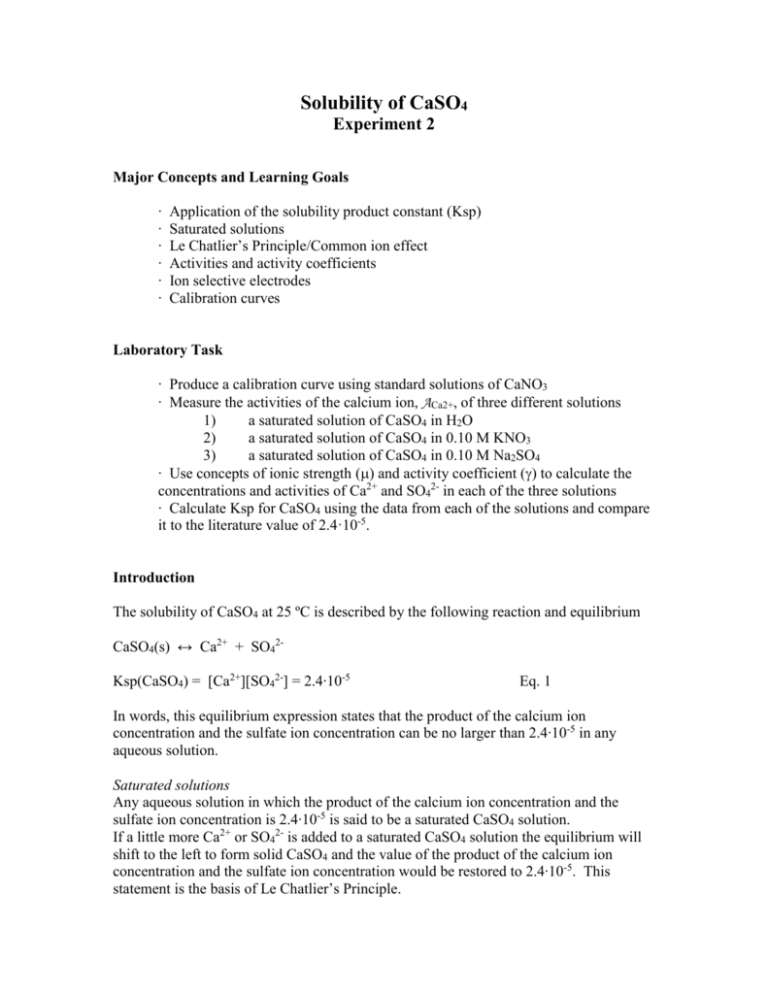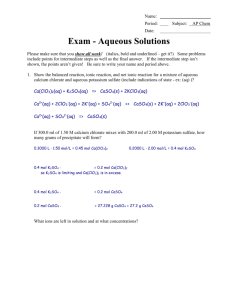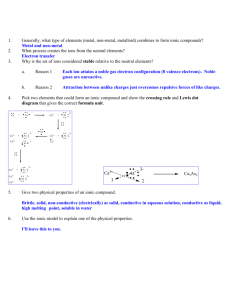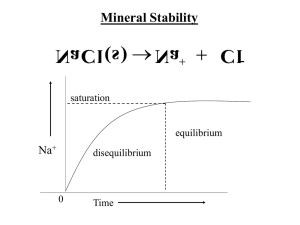Solubility of CaSO4
advertisement

Solubility of CaSO4 Experiment 2 Major Concepts and Learning Goals ∙ ∙ ∙ ∙ ∙ ∙ Application of the solubility product constant (Ksp) Saturated solutions Le Chatlier’s Principle/Common ion effect Activities and activity coefficients Ion selective electrodes Calibration curves Laboratory Task ∙ Produce a calibration curve using standard solutions of CaNO3 ∙ Measure the activities of the calcium ion, ACa2+, of three different solutions 1) a saturated solution of CaSO4 in H2O 2) a saturated solution of CaSO4 in 0.10 M KNO3 3) a saturated solution of CaSO4 in 0.10 M Na2SO4 ∙ Use concepts of ionic strength () and activity coefficient () to calculate the concentrations and activities of Ca2+ and SO42- in each of the three solutions ∙ Calculate Ksp for CaSO4 using the data from each of the solutions and compare it to the literature value of 2.4·10-5. Introduction The solubility of CaSO4 at 25 ºC is described by the following reaction and equilibrium CaSO4(s) ↔ Ca2+ + SO42Ksp(CaSO4) = [Ca2+][SO42-] = 2.4∙10-5 Eq. 1 In words, this equilibrium expression states that the product of the calcium ion concentration and the sulfate ion concentration can be no larger than 2.4∙10-5 in any aqueous solution. Saturated solutions Any aqueous solution in which the product of the calcium ion concentration and the sulfate ion concentration is 2.4∙10-5 is said to be a saturated CaSO4 solution. If a little more Ca2+ or SO42- is added to a saturated CaSO4 solution the equilibrium will shift to the left to form solid CaSO4 and the value of the product of the calcium ion concentration and the sulfate ion concentration would be restored to 2.4∙10-5. This statement is the basis of Le Chatlier’s Principle. When an equilibrium position of a reaction is disturbed, a new equilibrium position will be established by shifting the reaction in a direction that alleviates the stress caused by the disturbance Saturated solutions can be prepared by a variety of methods. In this experiment the first saturated solution has been prepared by adding solid CaSO4 to purified water (the water comes from a purification system that includes a carbon filter, an ion-exchange resin and a UV lamp). The solution was mixed for several days and allowed to settle and reach equilibrium for several weeks. Because the only source of the calcium ions and sulfate ions are from the dissolution of CaSO4, [Ca2+] = [SO42-]. In fact, the same statement can be made for the second saturated solution, since KNO3 is not a source of Ca2+ or SO42Based on the literature Ksp value, and ignoring activities (see below), the [Ca2+] of these first two saturated solutions are about 5.0∙10-3 M. Le Chatlier’s Principle and the Common Ion Effect One general case in which Le Chatlier’s principle can be applied is when the solution contains a soluble salt of an ion that is in common with the insoluble salt in question. This is the case in the third saturated solution; CaSO4 in dissolved 0.10 M Na2SO4. In this solution there are two sources of the sulfate ion; the Na2SO4 and the CaSO4. The [SO42-] concentration coming from the Na2SO4 is 0.10 M. The sulfate ion coming from the CaSO4 is equal to the calcium ion concentration. Thus, Ksp = [Ca2+] ([SO42-]CaSO4+ + [SO42-]Na2SO4) = 2.4∙10-5 Letting [Ca2+] = x, we arrive at Ksp = x (x + 0.10) = 2.4∙10-5 If we assume x <<< 0.10 M, then Ksp = x 0.10 = 2.4∙10-5 and [Ca2+] = 2.4∙10-4 M, This is considerably lower than the first saturated solution. It is also important to note that our solution verifies that our stated assumption was valid. This is lowering of the [Ca2+] is said to be due to the common ion effect. Activities and Activity Coefficients In reality, equilibria are affected by the concentration of ions, any ions, in solution. The ionic strength () is used as a measure of the total ion concentration of a solution. It is calculated by incorporating each of the “i” ionic species in solution to the following equation. = ½ ∑(CiZi2) So, why does the ionic strength matter? Well let’s look at the CaSO4 equilibrium as an example. The ionic strengths of the saturated solution 2 and 3 are considerably greater than that of saturated solution 1. Saturated solution 1 = ½ ([Ca2+](2)2 + [SO42-](-2)2)) = ½ (5∙10-3(2)2 + 5.0∙10-3(-2)2)) = 0.02 M Saturated solution 2 = ½ ([K+](1)2 + [NO3-](-1)2 + [Ca2+](2)2 + [SO42-](-2)2)) = ½ (0.1(1)2 + 0.1(-1)2 + 5∙10-3(2)2 + 5.0∙10-3(2)2)) = 0.12 M Saturated solution 3 = ½ ([Na+](1)2 + [SO42-](-2)2) + [Ca2+](2)2) = ½ (0.2(1)2 + 0.1(-2)2 + 2.4∙10-4(2)2 ) = 0.20 M Electrostatic interactions between the negative ions and the Ca2+ ions in solution cause the formation of an ion cloud around the Ca2+ ions. The larger the ionic strength of the solution the greater the radius of this ion cloud. A similar ion cloud forms around the SO42- ions from the positive ions in solution. The size of the ion clouds about Ca2+ and SO42- defines the energetics associated with these ions finding each other in solution and forming CaSO4(s). Thus, the product of the [Ca2+] and the [SO42-] in the second saturated solution would be expected to be greater than 5.0∙10-3 M, and in the third saturated solution the [Ca2+] would be expected to be greater than 2.4∙10-5 M and [SO42-] would be expected to be greater than 0.10 M. Mathematically, the effect of ionic strength is accounted for by introducing the concept of ion activity, A. The activity of an ion can be thought of as its effective concentration and is given by product of its concentration and activity coefficient, . The activity coefficient depends upon the size of the ion, its charge, and the ionic strength of the solution. For example: ACa2+ = [Ca2+] Ca+ The activity coefficient can be calculated using the Debye-Huckle equation. In this experiment estimates of the activity coefficients of Ca2+ and SO42- for the three saturated solutions will be provided with the corresponding spreadsheet. The most important concept to appreciate in terms of activities is that the definition of equilibrium expression that we first learn and used is a model that works very well at low ionic strengths, where the activity coefficients are close to unity. But the more universal model expresses the equilibrium constants in terms of activities. Equation 1 becomes Ksp(CaSO4) = ACa2+ASO42- = [Ca2+]Ca2+[SO42-]SO42- = 2.4∙10-5 Eq. 2 Ion-Selective Electrodes Ion-selective electrodes are electrochemical cells that have been carefully crafted into a probe that is useful for measuring the activity of a specific ion in solution. An ionselective electrode most often consists of two reference electrodes, which give a constant potential. The two reference electrodes are electrically linked via a voltmeter and a salt bridge through the solution being measured. The salt bridge consists of a membrane between the solution being measured and the inner reference electrode solution. This membrane is made of a unique material that preferentially allows the ion of interest to partially penetrate the membrane. This partial penetration leads to the development of a junction potential, the magnitude of which depends entirely on the activity of the ion in the solution being measured. The Ca2+ selective electrode used in this application uses a membrane that preferentially chelates Ca2+. The potential measured by the voltmeter depends upon the potential at each of the reference electrodes and the junction potential. The potential of the reference electrodes is constant and junction potential is only influenced by the activity of the Ca2+ in the solution being measure. Ecell = constant + 59.16/2 log ACa2+ Typically, one would measure the voltage of several standard Ca2+ solutions of known activities in the range of 0.1-10-6 M. Then, a calibration plot is produced by plotting the cell potential as a function of the log ACa2+. In the Lab 1. Make serial dilutions of the 0.100 M Ca(NO3)2 solution using a 10.00 mL pipet and several 100 mL volumetric flasks. You should end up with solutions at the following concentrations; 0.0100 M, 1.00∙10-3 M, 1.00∙10-4 M, 1.00∙10-5 M. The Corresponding activities of these solutions are as follows 0.0100 M, 1.00∙10-3 M, 1.00∙10-4 M, 1.00∙10-5 M. 2. Carefully pour about 25 mL of the three CaSO4 solutions into each of three 100 mL beakers. Label the beakers well. 3. Measure the cell voltages of each of the six standards and the three samples of different saturated CaSO4 solutions. Record all data on the Lab Pro Software and copy and paste the data into an Excel spread sheet. Lab Report Open the Excel file named “CASO4”. In the “standard curve” worksheet enter the Ecell readings. Be sure that the cells where the data are inputted correspond to the correct concentration of the standard. The graph will show the calibration plot (mV vs log ACa2+) for your Ca2+ ion selective electrode. The slope and intercept of the plot is also given and automatically placed on top of the worksheet labeled “CaSO4 solutions”. Go to this worksheet. Place the data you obtained for the cell potentials for your three CaSO4 solutions. For the first and second saturated solutions (saturated CaSO4 in H2O and saturated CaSO4 in 0.1 M KNO3) the spreadsheet calculates the ACa2+ from the standard curve parameters, then calculates the [Ca2+] using the estimated activity coefficient for Ca2+, which, as described above, must equal the [SO42-], then calculates the ASO42- from the estimated activity coefficient of SO42-, and finally we calculated the Ksp of CaSO4 from the product of the activities. log ACa2+ = (Ecell – intercept)/slope ACa2+ = 10 (log ACa2+) [Ca2+] = ACa2+ / Ca2+ [SO42-] = [Ca2+] ASO42- = [SO42-] SO42Ksp(CaSO4) = ACa2+ ASO42For the saturated CaSO4 solution in 0.10 M Na2SO4 the spreadsheet performs the same calculations, except that the [SO42-] is assumed to be 0.10 M. The average Ksp of CaSO4 is also calculated. Questions: 1. Compare and rationalize the relative magnitudes of the [Ca2+] in the three saturated CaSO4 solutions. 2. Are the three values for the Ksp of CaSO4 calculated from your experimental data in reasonable agreement? 3. Is the average value for the Ksp of CaSO4 calculated from your experimental data in reasonable agreement with the literature value of 2.4∙10-5?








